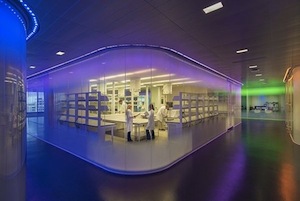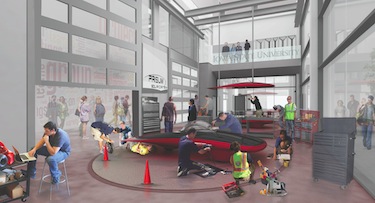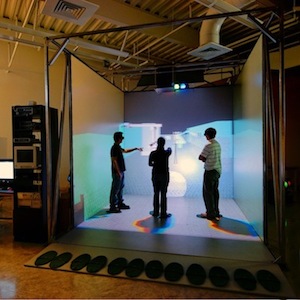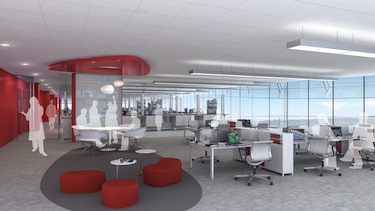Top Ten Trends For Design Led Science in 2013
Assuming the world does not end and the fiscal cliff is averted, you can be sure that in the scientific world there can be no more business as usual. The pace of change is increasing and we believe that the initiatives you will read about below are so close that you'll probably be experiencing them in the next 12 months. 1.New Business: The lingering recession has led even the most hardened scientific traditionalists to change their discovery structures. The world of academic science especially, is witnessing a dramatic change to performance-based strategies. This year we anticipate that more and more institutions will be investigating and creating efficiency and productivity performance target frameworks. By encouraging faculty to be more entrepreneurial, universities will become increasingly competitive in raising income, cutting costs and reorganizing to produce better science, faster. Like at the University at Buffalo Clinical Translational Research Center.
1.New Business: The lingering recession has led even the most hardened scientific traditionalists to change their discovery structures. The world of academic science especially, is witnessing a dramatic change to performance-based strategies. This year we anticipate that more and more institutions will be investigating and creating efficiency and productivity performance target frameworks. By encouraging faculty to be more entrepreneurial, universities will become increasingly competitive in raising income, cutting costs and reorganizing to produce better science, faster. Like at the University at Buffalo Clinical Translational Research Center.
2.New Cultures: The culture of science is changing. The traditional scientific method (seeking truth through reason) is increasingly influenced by other philosophical approaches previously considered irrelevant. New perspectives such as the heroic (seeking to win); the aesthetic (seeking beauty); the spiritual (seeking goodness); the economic (seeking systems) and the ecological (taking responsibility) are leading to the growth of a new type of scientist, one whose use of creative and artistic skills to solve problems is producing major new scientific directions. An example of this inter-philosophical attitude can be found at the University of California San Diego's Cal IT2 facility (http://www.calit2.net). Here scientists, artists, engineers and game designers combine their diversity of outlook to create dynamic discoveries in the intersecting worlds of nanotechnology, life science, information technology, and telecommunications.  3.New Learning: Demand for appropriately skilled graduates is forcing educational establishments to become increasingly market focused. Creating work ready, creative, entrepreneurial scientists who are responsible citizens and leaders is causing an explosive demand for new types of learning environments and innovative teachers. Traditional classrooms and teaching labs are being increasingly replaced by multimedia, real life learning experiences where digital and physical cross disciplinary team working skills are the essential ingredients for future career success.
3.New Learning: Demand for appropriately skilled graduates is forcing educational establishments to become increasingly market focused. Creating work ready, creative, entrepreneurial scientists who are responsible citizens and leaders is causing an explosive demand for new types of learning environments and innovative teachers. Traditional classrooms and teaching labs are being increasingly replaced by multimedia, real life learning experiences where digital and physical cross disciplinary team working skills are the essential ingredients for future career success.
4.New Senses: 2013 will see a shift away from the one-dimensional world of binary to a multifaceted world with human characteristics. Interfaces, which previously only responded to the sweep of a finger or the sound of a bleep, will evolve to both notify and respond to and from a wider range of human sensations: smell, taste and even emotion. The implications of this are wide ranging: personal environmental controls (like Twine), responsive clothing, bio-communications, automatic food distribution and smart power frameworks.
5.New Personalization: Bio-connectivity, real-time remote monitoring, and social networks will revolutionize health science. More and more people will use their personal devices to share their data and experiences with social and professional teams to accelerate healthcare solutions (My Fitnesspal, Nike Fuelband). In addition, every patient will become a source of research data. Developing population scale solutions through massive health data analysis will increasingly be used to drive public health solutions at local, regional and national levels.
6.New Shortages: As the recession continues we will see an increase in scientific shortages. Shortages of cost effective healthcare will lead to creative solutions by local boutique innovators (like Mali's Pesinet SMS system); skills shortages will lead to changes in education (see 3 above), shortage in industry growth and the end of stimulus funding will lead to academic research changing its enterprise model; Shortages in patent protected drugs will lead to major strategy changes in international bio-pharma. 7.New Magnetism: 2013 will be a year where opposites attract. The very big and very small: smart nano-systems will create efficient smart energy grids. The very dirty and the very clean: smart food production will be enhanced by low water and clean energy innovations. The digital and the human: new bio-digital interfaces in security and communications applications. The social and the professional: serious play will be incorporated into detailed digital simulations for epidemic and disaster planning. And yes, the beautiful and the ugly (you decide....)
7.New Magnetism: 2013 will be a year where opposites attract. The very big and very small: smart nano-systems will create efficient smart energy grids. The very dirty and the very clean: smart food production will be enhanced by low water and clean energy innovations. The digital and the human: new bio-digital interfaces in security and communications applications. The social and the professional: serious play will be incorporated into detailed digital simulations for epidemic and disaster planning. And yes, the beautiful and the ugly (you decide....)
8.New Geographies: 2013 will see the trend of emerging economies growth overtaking those of the west. Growth in China and India will occur not just through internal investment, but also by an increase in the creation and support of R&D and production initiatives by western industry in those countries. Change in Asia will not just be in volume, but also in innovation. As numbers of scientists and their cost reaches a critical mass, Asian corporations and universities will look to compete with the west through smarter, faster discovery and production methods.
9.New Partnerships: As R&D growth in the West flattens in 2013 we will see an increase in scientific public-private partnerships. This will occur in joint venture R&D such as Pacific Northwest National Lab's drive of technology transfer to commercial markets. Innovation in public private partnerships will also expand to integrate the delivery of scientific facilities with new hybrid discovery business models that not only fuse academic / government and corporate strengths but which also act to stimulate local economic regeneration. 10.New Spaces: The drive to do more with less, to drive productivity and to cross digital, social and geographical boundaries is leading to the demise of the traditional laboratory. The most forward thinking organizations are using innovative scientific business modeling fused with creative workplace strategies to produce new integrated discovery landscape that fuses the design of time (and how we use it), with the design of space. The old open lab and office combo is disappearing, to be replaced by hybrid multi use collaborative lab-office spaces infused with communication and data analysis technology coupled with low cost, high flexibility, high technology space. Like at the CJ Research and Development Center in South Korea.
10.New Spaces: The drive to do more with less, to drive productivity and to cross digital, social and geographical boundaries is leading to the demise of the traditional laboratory. The most forward thinking organizations are using innovative scientific business modeling fused with creative workplace strategies to produce new integrated discovery landscape that fuses the design of time (and how we use it), with the design of space. The old open lab and office combo is disappearing, to be replaced by hybrid multi use collaborative lab-office spaces infused with communication and data analysis technology coupled with low cost, high flexibility, high technology space. Like at the CJ Research and Development Center in South Korea.
Top Ten Trends For Design Led Science in 2013
The pace of change is increasing and we believe that the initiatives you will read about below are so close that you'll probably be experiencing them in the next 12 months.
This post was published on the now-closed HuffPost Contributor platform. Contributors control their own work and posted freely to our site. If you need to flag this entry as abusive, send us an email.

